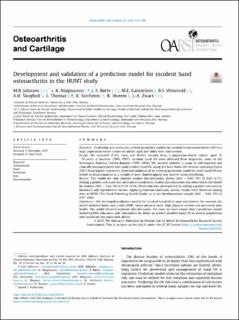| dc.contributor.author | Johnsen, Marianne Bakke | |
| dc.contributor.author | Magnusson, Karin | |
| dc.contributor.author | Børte, Sigrid | |
| dc.contributor.author | Gabrielsen, Maiken Elvestad | |
| dc.contributor.author | Winsvold, Bendik K S | |
| dc.contributor.author | Skogholt, Anne Heidi | |
| dc.contributor.author | Thomas, Laurent | |
| dc.contributor.author | Storheim, Kjersti | |
| dc.contributor.author | Hveem, Kristian | |
| dc.contributor.author | Zwart, John-Anker | |
| dc.date.accessioned | 2021-04-22T12:17:35Z | |
| dc.date.available | 2021-04-22T12:17:35Z | |
| dc.date.created | 2021-02-11T14:22:26Z | |
| dc.date.issued | 2020 | |
| dc.identifier.citation | Osteoarthritis and Cartilage. 2020, 28 (7), 932-940. | en_US |
| dc.identifier.issn | 1063-4584 | |
| dc.identifier.uri | https://hdl.handle.net/11250/2739159 | |
| dc.description.abstract | Objective
To develop and externally validate prediction models for incident hand osteoarthritis (OA) in a large population-based cohort of middle aged and older men and women.
Design
We included 17,153 men and 18,682 women from a population-based cohort, aged 35–70 years at baseline (1995–1997). Incident hand OA were obtained from diagnostic codes in the Norwegian National Patient Register (1995–2018). We studied whether a range of self-reported and clinically measured predictors could predict hand OA, using the Area Under the receiver-operating Curve (AUC) from logistic regression. External validation of an existing prediction model for male hand OA was tested on discrimination in a sample of men. Bootstrapping was used to avoid overfitting.
Results
The model for men showed modest discriminatory ability (AUC = 0.67, 95% CI 0.62–0.71). Adding a genetic risk score did not improve prediction. Similar discrimination was observed in the model for women (AUC = 0.62, 95% CI 0.59–0.64). Prediction was not improved by adding a genetic risk score or hormonal and reproductive factors. Applying external validation, similar results were observed among men in HUNT (The Nord-Trøndelag Health Study) as in the developmental sample (AUC = 0.62, 95% CI 0.57–0.65).
Conclusion
We developed prediction models for incident hand OA in men and women. For women, the model included body mass index (BMI), heavy physical work, high physical activity and perceived poor health. The model showed moderate discrimination. For men, we have shown that a prediction model including BMI, education and information on sleep can predict incident hand OA in several populations with moderate discriminative ability. | en_US |
| dc.language.iso | eng | en_US |
| dc.publisher | Elsevier Science | en_US |
| dc.rights | Navngivelse 4.0 Internasjonal | * |
| dc.rights.uri | http://creativecommons.org/licenses/by/4.0/deed.no | * |
| dc.title | Development and validation of a prediction model for incident hand osteoarthritis in the HUNT study | en_US |
| dc.type | Peer reviewed | en_US |
| dc.type | Journal article | en_US |
| dc.description.version | publishedVersion | en_US |
| dc.source.pagenumber | 932-940 | en_US |
| dc.source.volume | 28 | en_US |
| dc.source.journal | Osteoarthritis and Cartilage | en_US |
| dc.source.issue | 7 | en_US |
| dc.identifier.doi | 10.1016/j.joca.2020.04.005 | |
| dc.identifier.cristin | 1888890 | |
| dc.description.localcode | This is an open access article distributed under the terms of the Creative Commons CC-BY license, which permits unrestricted use, distribution, and reproduction in any medium, provided the original work is properly cited. | en_US |
| cristin.ispublished | true | |
| cristin.fulltext | original | |
| cristin.qualitycode | 1 | |

